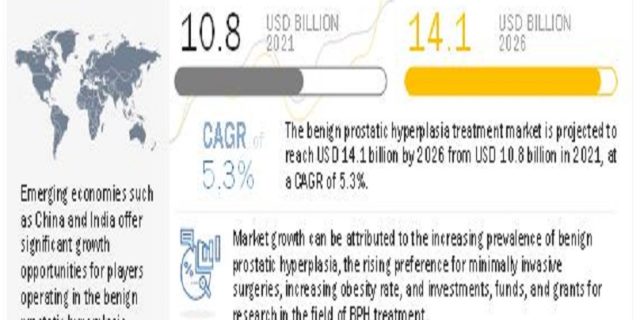
The growth of Benign Prostatic Hyperplasia Treatment Market is driven by the increasing prevalence of benign prostatic hyperplasia, the rising preference for minimally invasive surgeries, increasing obesity rate, and investments, funds, and grants for research in the field of BPH treatment.
The Benign prostatic hyperplasia treatment market is projected to reach USD 14.1 billion by 2026 from USD 10.8 billion in 2021, at a CAGR of 5.3% from 2021 to 2026.
Download PDF Brochure: – https://www.marketsandmarkets.com/pdfdownloadNew.asp?id=198000374
Key growth driving factors: –
- Aging Population: The prevalence of BPH increases with age, and as the global population continues to age, the number of individuals suffering from BPH is expected to rise.
- Increasing Awareness: There is a growing awareness among both patients and healthcare professionals about BPH and its available treatment options. This increased awareness can lead to early diagnosis and treatment, driving the demand for BPH therapies.
- Advancements in Treatment Options: Ongoing research and development efforts have led to the introduction of innovative treatment options for BPH. Minimally invasive procedures, new drug therapies, and alternative therapies offer more choices to patients, which can drive market growth.
- Technological Advancements: Technological advancements in the medical field have led to the development of advanced diagnostic tools and treatment techniques for BPH. These advancements make treatments safer and more effective, attracting patients and healthcare providers to adopt them.
- Healthcare Infrastructure: Improvements in healthcare infrastructure, particularly in emerging markets, are expanding access to BPH diagnosis and treatment. This can significantly boost the market’s growth potential.
- Lifestyle Factors: Lifestyle factors such as obesity and sedentary lifestyles are associated with an increased risk of BPH. As these factors become more prevalent globally, they can contribute to the growth of the BPH treatment market.
- Globalization of Healthcare: The globalization of healthcare has made it easier for patients to access medical treatment options in different countries, potentially expanding the market for BPH treatments.
Market Segmentation: –
Based on the type, the BPH treatment market is segmented into drug treatment and surgical treatment. Drug treatment is the largest and the fastest-growing segment in this market. This can primarily be attributed to the use of medications as the first line of treatment among men with mild to moderate symptoms of BPH.
Based on the end user, the market is segmented into home healthcare and hospitals & clinics. In 2019, home healthcare accounted for the largest share of this market, as most patients are prescribed medications over surgery.
Regional Analysis:
On the basis of region, the benign prostatic hyperplasia treatment market is segmented into North America, Europe, Asia Pacific, and the Rest of the World. In 2019, North America commanded the largest share of the benign prostatic hyperplasia treatment market.
North America:
- North America, including the United States and Canada, has a well-established healthcare infrastructure and a high prevalence of BPH due to an aging population.
- The region often experiences early adoption of new BPH treatments and technologies.
Europe:
- European countries, such as the United Kingdom, Germany, and France, have aging populations and high awareness of BPH.
- The market here is driven by both surgical and non-surgical treatment options.
Asia-Pacific:
- The Asia-Pacific region, including countries like China, India, and Japan, has a rapidly aging population, contributing to a rising prevalence of BPH.
- The market can experience significant growth due to increased awareness and expanding healthcare infrastructure.
Latin America:
- Latin American countries, including Brazil and Mexico, are witnessing an increase in BPH cases with aging populations.
- Market growth can be influenced by healthcare accessibility and affordability.
Middle East and Africa:
- The prevalence of BPH is rising in this region, particularly due to demographic changes.
- Healthcare infrastructure can vary widely between countries, affecting market development.
Request for Sample Pages: – https://www.marketsandmarkets.com/requestsampleNew.asp?id=198000374
Recent Developments
- In 2021, In January 2021, PHAREX Health Corporation in partnership with the Philippine Urological Association (PUA), launched Pharex Tamsulosin for BPH treatment.
- In 2020, UroLift launched Advanced Tissue Control (ATC) System
- In 2020, Asahi Kasei Pharma obtained Chinese approval for Flivas (naftopidil).
- In 2019, Alembic received approval from the US FDA for its Abbreviated New Drug Application (ANDA) for Silodosin Capsules 4 mg and 8 mg
- In 2018, NxThera’s Rezûm system, a minimally invasive therapy (MIT) for patients with BPH, was included under Boston’s Urology and Pelvic Health business.
Top Key Players: –
The major players operating in this market are Boston Scientific Corporation (US), Coloplast Group (Denmark), Teleflex Incorporated (US), Olympus Corporation (Japan), GlaxoSmithKline PLC (UK), Eli Lilly (US), Pfizer, Inc. (US), Abbott (US), Asahi Kasei Corporation (Japan), Merck & Co., Inc. (US), Astellas Pharma Inc. (Japan), Allergan plc (Ireland), Alembic (India), IPG Photonics Corporation (US), Richard Wolf GmbH (Germany), Unilab, Inc. (Philippines), Pharex Health Corporation (Philippines), Biolitec AG (Austria), Urologix, LLC (US), Advin Health Care (India), Medifocus, Inc. (Canada), Asclepion Laser Technologies GmbH (Germany), Pnn Medical A/S (Denmark), Surgical Lasers Inc. (Canada). Quanta Systems (Italy), Allium Ltd. (Israel), Lumenis Ltd. (Israel), KARL STORZ SE & Co. KG (Germany), and SRS Medical (US).
Conclusion
In conclusion, the global market for BPH treatment is expected to grow in the coming years, driven by the increasing prevalence of BPH among the aging population and the demand for minimally invasive procedures. With the advent of new and innovative treatment options, the BPH treatment market is poised for further growth and development in the future.

